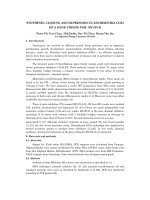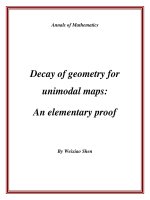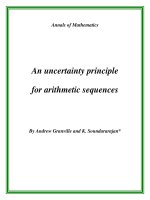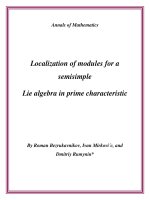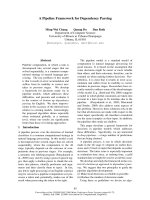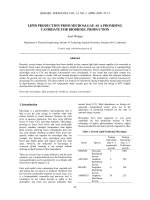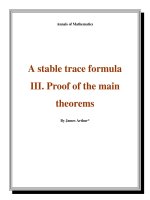Đề tài " A preparation theorem for codimension-one foliations " ppt
Bạn đang xem bản rút gọn của tài liệu. Xem và tải ngay bản đầy đủ của tài liệu tại đây (354.08 KB, 15 trang )
Annals of Mathematics
A preparation theorem
for codimension-one
foliations
By Frank Loray
Annals of Mathematics, 163 (2006), 709–722
A preparation theorem
for codimension-one foliations
By Frank Loray*
Dedicated to C´esar Camacho for his 60
th
birthday
Abstract
After gluing foliated complex manifolds, we derive a preparation-like the-
orem for singularities of codimension-one foliations and planar vector fields (in
the real or complex setting). Without computation, we retrieve and improve
results of Levinson-Moser for functions, Dufour-Zhitomirskii for nondegenerate
codimension-one foliations (proving in turn the analyticity), Str´o˙zyna-
˙
Zoladek
for non degenerate planar vector fields and Bruno-
´
Ecalle for saddle-node foli-
ations in the plane.
Introduction
We denote by (z
,w) the variable of C
n+1
, z =(z
1
, ,z
n
), for n ≥ 1.
Recall that a germ of (non-identically vanishing) holomorphic 1-form
Θ=f
1
(z,w)dz
1
+ ···+ f
n
(z,w)dz
n
+ g(z,w)dw
f
1
, ,f
n
,g ∈ C{z,w}, defines a codimension-1 singular foliation F (regular
outside the zero-set of Θ) if, and only if, it satisfies the Frobenius integrability
condition Θ ∧ dΘ = 0. Maybe after division of coefficients of Θ by a common
factor, the zero-set of Θ has codimension-2 and the foliation F extends as a
regular foliation outside this sharp singular set.
Our main result is
Theorem 1. Let Θ and F be as above and assume that g(0
,w) vanishes
at the order k ∈ N
∗
at 0. Then, up to analytic change of the w-coordinate
w := φ(z
,w), the foliation F is also defined by a 1-form
Θ=P
1
(z,w)dz
1
+ ···+ P
n
(z,w)dz
n
+ Q(z,w)dw
for w-polynomials P
1
, ,P
n
,Q∈ C{z}[w] of degree ≤ k, Q monic.
*The preliminary version [9] of this work was written during a visit at C.R.M.
(Barcelona); we thank Marcel Nicolau and the C.R.M. for hospitality.
710 FRANK LORAY
In new coordinates given by Theorem 1, the singular foliation F extends
analytically along some infinite cylinder {|z
| <r}×C (where C = C ∪ {∞}
stands for the Riemann sphere). To prove this theorem, we just do the con-
verse. Given a germ of foliation, we force its endless analytic continuation in
one direction by constructing it in the simplest way, gluing foliated manifolds
into a foliated
C-bundle. This is done in Section 1. The huge degree of freedom
encountered during our construction can be used to preserve additional struc-
ture equipping the foliation. For instance, starting with the complexification of
a real analytic foliation, our gluing construction can be carried out preserving
the anti-holomorphic involution (z
,w) → (z, w) so that our statement agrees
with the real setting. In the same way, if one starts with a closed meromorphic
1-form Θ, one can arrange so that Θ extends meromorphically as well along the
infinite cylinder (see Section 2) and becomes itself rational in w. In particular,
in the case Θ = df is exact, we derive a short proof of the following alternate
Preparation Theorem.
Theorem 2 (Levinson). Let f(z
,w) be a germ of holomorphic function
at (0
, 0) in C
n+1
and assume that f(0,w) vanishes at the order k ∈ N
∗
at
w =0. Then, up to an analytic change of coordinates, the function germ f
becomes a monic w-polynomial of degree k,
f(z
,w)=w
k
+ f
k−1
(z)w
k−1
+ ···+ f
0
(z),
where f
0
, ,f
k−1
∈ C{z}.
The difference from the Weierstrass Preparation Theorem lies in the fact
that the usual invertible factor term (in variables (z
,w)) is normalized to 1
here; the counterpart is that a change of coordinates is needed. This result
was previously obtained by N. Levinson in [8] after an iterative procedure
and proved again by J. Moser in [15] as an example illustrating KAM fast
convergence. Similarly, we obtain that any germ of a meromorphic function is
conjugated to a quotient of Weierstrass w-polynomials (see Theorem 2.1).
For k = 1, Theorem 1 reads as follows.
Corollary 3. Let Θ and F be as in Theorem 1 and assume that the
linear part of Θ is not tangent to the radial vector field
n
i=1
z
i
∂
z
i
+ w∂
w
.
Then, there exist local analytic coordinates (z
,w) in which the foliation F is
defined by
Θ=df
0
+ wdf
1
+ wdw
where f
0
,f
1
∈ C{z} satisfy df
0
∧ df
1
=0.
Following [12], the functions f
i
factor into a primitive function f and the
foliation F is actually the lifting of a foliation in the plane by the holomor-
phic map Φ : (C
n+1
, 0) → (C
2
, 0); (z,w) → (f(z),w). This normal form was
A PREPARATION THEOREM FOR FOLIATIONS
711
obtained in [3] by J P. Dufour and M. Zhitomirskii after a formal change of
coordinates but the convergence was not proved.
In Theorem 1, the
C-fibration is constructed simultaneously with the ex-
tension of the foliation F by gluing bifoliated manifolds. In dimension 2,
when F is defined by a vector field X, it is still possible to extend X on a
2-dimensional tubular neighborhood M of an embedded sphere
C but it is
not possible to construct the
C-fibration at the same time. Here, we need
the Rigidity Theorem of V. I. Savelev [17] (see also [21]): the germ of a
2-dimensional neighborhood of an embedded sphere having zero self-intersection
is a trivial
C-bundle over the disc. In Section 3, we derive, for nondegenerate
singularities of vector fields
Theorem 4. Let X be a germ of an analytic vector field vanishing at the
origin of R
2
(resp. of C
2
). Assume that its linear part is not radial, i.e. not
of the form λ(x∂
x
+ y∂
y
), λ ∈ C. Then, there exist local analytic coordinates
(x, y) in which
X =(y + f(x))∂
x
+ g(x)∂
y
where f,g ∈ R{x} (resp. f,g ∈ C{x}) vanish at 0.
Denote by λ
1
,λ
2
∈ C the eigenvalues of the vector field X: we have
λ
1
+ λ
2
= f
(0) and λ
1
· λ
2
= −g
(0). In the case λ
2
= −λ
1
(including
the nilpotent case λ
i
= 0), Theorem 4 was obtained by E. Str´o˙zyna and
H.
˙
Zoladek [19]. They proved the convergence of an explicit iterative reduction
process after long and technical estimates. In the case λ
2
/λ
1
∈ R
−
, Theorem 4
becomes just useless since H. Poincar´e and H. Dulac gave a unique and very
simple polynomial normal form. In the remaining case, taking into account
the invariant curve of the vector field X, we can specify our normal form as
follows (see Section 3 for a statement including nilpotent singularities).
Corollary 5. Let X be a germ of an analytic vector field in the real or
complex plane with eigenratio λ
2
/λ
1
∈ R
−
. Then, there exist local analytic
coordinates in which the vector field X takes the forms:
(1) In the saddle case λ
2
/λ
1
∈ R
−
∗
(with λ
1
,λ
2
∈ R in the real case),
X = f(x + y) {(λ
1
x∂
x
+ λ
2
y∂
y
)+g(x + y)(x∂
x
+ y∂
y
)} .
(2) In the saddle-node case, say λ
2
=0, λ
1
=0,
X = f(x) {(λ
1
x + y)∂
x
+ g(x)y∂
y
} .
(3) In the real center case λ
2
= −λ
1
= iλ, λ ∈ R,
X = f(x) {(−λy∂
x
+ λx∂
y
)+g(x)(x∂
x
+ y∂
y
)} .
In each case, f(0) = 1 and g(0) = 0.
712 FRANK LORAY
The orbital normal form (i.e. the normal form for the induced foliation)
can be immediately derived just by setting f ≡ 1: coefficient g stands for the
moduli of the foliation. The normal form (3) was also derived in [19].
In case (1), A. D. Bruno proved in [1] that the vector field X is actually
analytically linearisable for generic eigenratio λ
2
/λ
1
∈ R
−
(in the sense of
the Lebesgue measure). In this case, normal form (1) of Corollary 5 becomes
just useless. For the remaining exceptional values, the respective works of
J C. Yoccoz in the diophantine case (see [22] and [16]) and J. Martinet with
J P. Ramis in the resonant case λ
2
/λ
1
∈ Q
−
(see [11]) derive a huge moduli
space for the analytic classification of the induced foliations. This suggests
that most of the vector fields having such eigenvalues are not polynomial in
any analytic coordinates. Moreover, at least in the resonant case, the analytic
classification of all vector fields inducing a given foliation gives rise to functional
moduli as well (see [7], [13] and [20]). Thus, the functional parameters f and
g appearing in our normal form seem necessary in many cases.
Finally, one can shortly derive from (2) a versal deformation
X
f
= x∂
x
+ y
2
∂
y
+ yf(x)∂
x
,f∈ C{x},
of the saddle-node foliation F
0
defined by X
0
= x∂
x
+ y
2
∂
y
(see [10]). In
other words, any germ of analytic deformation of X
0
without bifurcation of
the saddle-node point factor into the family above after analytic change of
coordinates and renormalization. Moreover, the derivative of Martinet-Ramis’
moduli map at X
0
(see [5]) is bijective. When f(0) = 0, one can even show
that the form above is unique. This result was announced by A. D. Bruno in
[2] and proved by J.
´
Ecalle at the end of [4] using mould theory in the particular
case f
(0) = 0. We will detail it in a forthcoming paper [10].
1. Preparation theorem for codimension-1 foliations
We first prove Theorem 1. Let F
0
denote the germ of singular foliation
defined by an integrable holomorphic 1-form at (0
, 0) ∈ C
n+1
:
Θ
0
= f
1
(z,w)dz
1
+ ···+ f
n
(z,w)dz
n
+ g(z,w)dw, Θ
0
∧ dΘ
0
=0,
f
1
, ,f
n
,g ∈ C{z,w} and assume g(0,w) ≡ 0. In particular, for r>0
small enough, the foliation F
0
is well-defined on the vertical disc ∆
0
= {0}×
{|w| <r}, regular and transversal to ∆
0
outside w =0.
Consider in C
n
×C the vertical line L = {0}×C together with the covering
given by ∆
0
and another disc, say ∆
∞
= {0}×{|w| >r/2}. Denote by
C =∆
0
∩ ∆
∞
the intersection corona. By the flow-box theorem, there exists
a unique germ of a diffeomorphism of the form
Φ:(C
n+1
,C) → (C
n+1
,C); (z,w) → (z,φ(z,w)),φ(0,w)=w
A PREPARATION THEOREM FOR FOLIATIONS
713
conjugating F
0
to the horizontal foliation F
∞
(defined by Θ
∞
= dw)atthe
neighborhood of the corona C. Therefore, after gluing the germs of complex
manifolds (C
n
× C, ∆
0
) and (C
n
× C, ∆
∞
) along the corona by means of Φ,
we obtain a germ of a smooth complex manifold M, dim(M)=n + 1, along a
rational curve L equipped with a singular holomorphic foliation F. Moreover,
the coordinate z
, which is invariant under the gluing map Φ, defines a germ of
a rational fibration z
:(M,L) → (C
n
, 0). By [6], there exists a germ of submer-
sion w :(M,L) → L
C completing z into a system of trivializing coordinates
(z
,w):(M,L) → (C
n
, 0) × C. This system is unique up to permissible change
(˜z
, ˜w)=
φ(z),
a(z
)w + b(z)
c(z)w + d(z)
where a, b, c, d ∈ C{z
}, ad − bc ≡ 0, and φ ∈ Diff(C
n
, 0).
In the neighborhood of any point p ∈ L, the foliation F is defined by
a (nonunique) germ of a holomorphic 1-form (respectively Θ
0
or Θ
∞
). After
division by the coefficient of dw, F is equivalently defined by a germ of a
meromorphic 1-form
Θ=R
1
(z,w)dz
1
+ ···+ R
n
(z,w)dz
n
+ dw,
where R
i
are meromorphic at p. This normal form is unique and Θ is therefore
globally defined on the neighborhood of L. In restriction to each rational fiber
{z
= constant}, R
i
is a global meromorphic function, thus a rational function
by Chow’s theorem. In other words, the functions R
i
are actually rational in
the variable w; i.e. all coefficients R
i
are quotients of Weierstrass polynomials.
Choose trivializing coordinates (z
,w) so that the singular point of F is
still located at w = 0. The poles of Θ correspond to tangencies between the
foliation F and the rational fibration (counted with multiplicity). Denote by
Σ this divisor. Since F
∞
is transversal to the rational fibration, those poles
come from the first chart, namely from the corresponding tangency divisor
Σ
0
= {g(z,w)=0}.
By assumption, the total number of tangencies between F (or F
0
) and a fibre
(close to L)isk. It follows that the w-rational coefficients R
i
have exactly k
poles (counted with multiplicity) in restriction to each fiber. Therefore, if Q
denotes the monic w-polynomial of degree k defining Σ and if one lets R
i
=
P
i
Q
for w-polynomials P
i
, the transversality of F with the fibration at {w = ∞}
implies that the P
i
’s have at most degree k +2 in the variable w. Equivalently,
F is defined by
Θ=θ
0
+ θ
1
w + ···+ θ
k+2
w
k+2
+ Q(z,w)dw
for evident 1-forms θ
0
,θ
1
, ,θ
k
on (C
n
, 0) (depending only on z).
After a permissible change of the w-coordinate, one may assume that
the line {w = ∞} at infinity is a leaf of the foliation (just straighten one
714 FRANK LORAY
F
0
Σ
0
∆
0
Φ
∆
∞
F
∞
Figure 1: Gluing construction
leaf); i.e., θ
k+2
= 0. In fact, one may furthermore assume that the con-
tact between F and the horizontal fibration {w = constant} along the line
{w = ∞} has multiplicity 2 (there is no linear holonomy along this leaf in the
w-coordinate). Indeed, the change of coordinate ˜w = e
−
θ
k+1
w (θ
k+1
is closed
by the integrability condition
Θ ∧ d
Θ = 0). In new coordinates, θ
k+1
= 0 and
Theorem 1 is proved. Notice that we can further simplify the form
Θ by using
the remaining possible changes of coordinates ˜z
= φ(z) and ˜w = w + b(z).
We now prove Corollary 3. According to the begining of the proof above,
if the linear part of Θ
0
is not tangent to the radial vector field, up to a
linear change of coordinates, one may assume that the tangency set Σ
0
=
{g(
z,w)=0} between the foliation F
0
and the vertical fibration {z = constant}
is smooth and transverse to the fibration. By the assumption of Theorem 1
with k = 1, up to a change of the w-coordinate, one may assume that F is
defined by
Θ=θ
0
+ wθ
1
+(w + f(z))dw where θ
0
and θ
1
are holomorphic
1-forms depending only on the z
-variable and f ∈ C{z}. After translation
w := w + f(z
) (notice that f(0) = 0), one may assume furthermore that f ≡ 0
and the integrability condition
Θ ∧ d
Θ = 0 yields
θ
0
∧ θ
1
=0,dθ
0
= 0 and dθ
1
=0.
After integration, we obtain θ
i
= df
i
for functions f
i
∈ C{z} with the tangency
condition df
0
∧ df
1
= 0; Corollary 3 is proved. By [12], there exists a prim-
itive function f ∈ C{z
} (with connected fibres) through which f
0
and f
1
factor:
f
i
=
˜
f
i
◦ f with
˜
f
i
∈ C{z}, z a single variable. Notice that we can further
A PREPARATION THEOREM FOR FOLIATIONS
715
L ∼ C
F
Σ
{w = ∞}
M
Figure 2: Uniformisation
simplify the form
Θ by using the remaining possible changes of coordinate
˜z
= φ(z).
If we start with a real analytic foliation F
0
, then its complexification is
invariant under the anti-holomorphic involution (z
,w) → (z, w). This involu-
tion obviously commutes with F
∞
and with the gluing map Φ, defining, this
way, a germ of anti-holomorphic involution Ψ : (M,L) → (M, L) on the re-
sulting manifold preserving F. By restriction to the coordinate
z, which is
invariant under Φ and well defined on M , Ψ induces the standard involution
z
→ z. Therefore, Ψ(z,w)=(z,ψ(z,w)) where ψ(z,w) is, for fixed z, a reflec-
tion with respect to a real circle. After a holomorphic change of w-coordinate,
ψ(z
,w)=w and the constructed foliation F is actually invariant by the stan-
dard involution. The unique meromorphic 1-form defining F,
Θ=R
1
(z,w)dz
1
+ ···+ R
n
(z,w)dz
n
+ dw,
satisfies Ψ
∗
Θ=Θ and its coefficients are actually real: R
i
∈ R{z}(w). This
real form is obtained up to a global change of coordinates commuting with the
standard involution; that is,
(˜z
, ˜w)=
φ(z),
a(z
)w + b(z)
c(z)w + d(z)
where a, b, c, d ∈ R{z
}, ad − bc ≡ 0, and φ ∈ Diff(R
n
, 0).
716 FRANK LORAY
2. Preparation theorem for closed meromorphic 1-forms
For simplicity, we start with the case of (meromorphic) functions:
Theorem 2.1. Let f be a germ of a meromorphic function at (0
, 0) in
C
n+1
and assume that f(0,w) is a well-defined and non constant germ of a
meromorphic function. Then, up to analytic change of the w-coordinate w :=
φ(z
,w), the function f becomes a w-rational function
f(z
,w)=
f
0
(z)+f
1
(z)w + ···+ f
k
0
−1
(z)w
k
0
−1
+ w
k
0
g
0
(z)+g
1
(z)w + ···+ g
k
∞
−1
(z)w
k
∞
−1
+ w
k
∞
where k
0
,k
∞
∈ N and f
i
,g
j
∈ C{z}.
Proof. Denote by f
0
(z,w) the germ of a meromorphic function above
and make a preliminary change of coordinate ˜w := ϕ(w) such that f
0
(0,w)=
w
l
, l ∈ Z
∗
,or1+w
l
, l ∈ N
∗
. Then, proceed with the underlying foliation
F
0
(defined by f
0
= constant) as in the proof of Theorem 1 in Section 1.
By construction, the function f
0
will glue automatically with the respective
function f
∞
(z,w)=w
l
or 1 + w
l
defining F
∞
. Therefore, the global foliation
F is actually defined by a global meromorphic function f on M. Again, f is
a quotient of Weierstrass polynomials. In the case f
0
(0,w)=w
l
, choose the
w-coordinate such that the zero or pole of f
∞
(z,w)=w
l
still coincides with
{w = ∞}. Therefore, k
0
and k
∞
respectively coincide with the number of
zeroes and poles of f
0
restricted to a generic vertical line (close to L). In the
other case f
0
(0,w)=1+w
l
, we add l simple zeroes in the finite part and a
pole of order l that can be straightened to {w = ∞} as before. In this latter
case, l = k
0
− k
∞
> 0 and k
∞
is the number of (zeroes or) poles of f
0
(z,w)
restricted to a generic vertical line. In any case, the leading terms f
k
0
and g
k
∞
are nonvanishing at z =0and can be normalized to 1 by division and a further
change of coordinate ˜w = a(z
)w.
The proof of Theorem 2 immediately follows when we set k = k
0
> 0 and
k
∞
= 0 in the proof above.
Proposition 2.2. Let Θ be a germ of a closed meromorphic 1-form at
(0
, 0) ∈ C
n+1
and assume that the vertical line {z =0} is not invariant by
the induced foliation. Then, up to analytic change of the w-coordinate w :=
φ(z
,w), the closed form Θ takes the form
Θ=
P
1
(z,w)dz
1
+ ···+ P
n
(z,w)dz
n
+ P (z,w)dw
Q(z,w)
for w-polynomials P, Q, P
1
, ,P
n
∈ C{z}[w].
A PREPARATION THEOREM FOR FOLIATIONS
717
Proof. By a preliminary change of the w-coordinate, one can normalize
the restriction of Θ to the vertical line into one of the models
Θ|
L
= w
k
dw if k ≥ 0,
Θ|
L
= λ
dw
w
if k = −1,
Θ|
L
= λ
dw
w
k
(1 − w)
if k<−1,
where k ∈ Z stands for the order of Θ|
L
at w = 0 and λ ∈ C denotes the residue
when k ≤−1. Then, defining the horizontal foliation F
∞
by the corresponding
model Θ
∞
above (viewed as a 1-form in variables (z,w)), we proceed gluing the
foliations and the 1-forms as we did with functions in the previous proof. If k
0
and k
∞
denote the respective number of zeroes and poles of Θ
0
in restriction
to a generic vertical line, then the numerator and denominator have respective
degrees k
0
and k
∞
if k
0
− k
∞
≥−1 and k
0
and k
∞
+1ifk
0
− k
∞
< −1.
3. Nondegenerate vector fields in the plane
We prove Theorem 4 and deduce Corollary 5. Let X
0
be a germ of an
analytic vector field at (0, 0) ∈ C
2
,
X
0
= f(z, w)∂
z
+ g(z, w)∂
w
,
vanishing at (0, 0) with a nonradial linear part:
lin(X
0
)=(az + bw)∂
z
+(cz + dw)∂
w
=
ab
cd
=
λ 0
0 λ
(in particular, it is assumed that the linear part is not the zero matrix). One
can find linear coordinates in which
lin(X
0
)=
01
αβ
+ ···
where −α and β respectively stand for the product and the sum of the eigen-
values λ
1
and λ
2
. The eigenvector corresponding to λ
i
is (1,λ
i
); in the case
λ
1
= λ
2
, we note that the matrix above is not diagonal. After a change of the
w-coordinate of the form w := ϕ(w), we may assume that restriction of f(z,w)
to the vertical line {z =0} takes the form f (0,w)=w. Similarly, to the proof
of Theorem 1 in Section 1, we consider in C ×
C the vertical line L = {0}×C
together with the covering given by
∆
0
= {0}×{|w| <r} and ∆
∞
= {0}×{|w| >r/2}.
Also we denote by C =∆
0
∩ ∆
∞
the intersection corona.
If r>0 is small enough, the vector field X
0
is well defined on the neigh-
borhood of the closed disc
∆
0
and transverse to it outside w = 0. By the
718 FRANK LORAY
rectification theorem, there exists a unique germ of a diffeomorphism of the
form
Φ:(C
2
,C) → (C
2
,C), Φ(0,w)=(0,w)
conjugating X
0
to the horizontal vector field X
∞
= w∂
z
. After gluing the
germs of complex surfaces (C ×
C, ∆
0
) and (C × C, ∆
∞
) along the corona by
means of Φ, we obtain a germ of smooth complex surface M along a rational
curve L equipped with a meromorphic vector field X. Since the ∂
z
-component
of X
0
agrees with w∂
z
along L, it follows that the Jacobian of the gluing map
Φ takes the form
D
(0,w)
Φ=
10
∗ 1
and the embedded rational curve L has zero self-intersection. Following [17],
we see that L is the regular fiber of a germ of a trivial fibration on M, i.e. there
exist global coordinates (z, w):(M,L) → (C, 0
) × C sending L onto {z =0}.
The vector field X has exactly one isolated zero, say (z,w)=(0, 0), and a
simple pole along a trajectory (given by X
∞
= w∂
z
in the second chart) that
we may assume still given by {w = ∞}. The tangency divisor Σ between the
induced foliation F and the fibration {z = constant} still is a smooth curve
intersecting the fiber {z =0} at the singular point (z, w)=(0, 0) without
multiplicity. Indeed, the Jacobian of the change of coordinates (from the first
chart to the global coordinates) at the singular point fixes the w-direction, so
that the linear part of the vector field takes the form
X =
ab
cd
+ ··· ,b=0.
As in the proof of Theorem 1, one may choose the (global) w-coordinate
so that the foliation has a contact of order 2 with the horizontal foliation
{w = constant} along the polar trajectory {w = ∞} and the tangency set
Σ={w =0} is horizontal as well. Therefore, the vector field X is written
X = f(z)w∂
z
+(g
0
(z)+wg
1
(z))∂
w
for germs f,g
0
,g
1
∈ C{z}. Indeed, the coefficients of X = P (z, w)∂
z
+
Q(z,w)∂
w
become automatically rational in the w-variable. Since the unique
pole of X is simple and located at {w = ∞}, P and Q are in fact polynomials
of maximal degree 1 and 3 (notice that ∂
w
has a double zero at {w = ∞}).
Finally, conditions on tangency and polar sets imply the special form above.
By a change of z-coordinate, we may furthermore assume f(z) ≡ 1(f (0) =
1 = 0). Automatically, the linear part of X in the new coordinates is
X =
01
αβ
+ ···
A PREPARATION THEOREM FOR FOLIATIONS
719
L ∼ C
Σ={w =0}
{w =0}
Figure 3: Normalisation
i.e. g
0
(z)=αz + ··· and g
1
(z)=β + ··· where dots mean higher order terms.
Finally, the form X =(w + f(z))∂
z
+ g(z)∂
w
is derived after the last change
of coordinate ˜w := w − f where f
(z)=g
1
(z), f (0) = 0.
If we start with a real vector field X
0
, then the anti-holomorphic involution
(z,w) → (
z,w) commutes with the gluing map Φ (mind that X
∞
= w∂
z
is also
real) and induces a germ of anti-holomorphic involution Ψ : (M,L) → (M,L)
on the resulting surface satisfying
Ψ
∗
X = X. By Blanchard’s argument, Ψ
permutes the rational fibration: for any line L
close to L, the restriction of y
along the image Ψ(L
) is an anti-holomorphic map from a compact manifold
into a bounded domain; therefore, y|
Ψ(L
)
is constant and Ψ(L
) is actually a
fiber of y. In restriction to the coordinate z, Ψ is a regular anti-holomorphic
involution and is obviously holomorphically conjugated to the standard one
z →
z. Finally, after holomorphic change of w-coordinate, Ψ(z, w)=(z,w)
and X has real coefficients.
Corollary 3.1. Let X be a germ of an analytic vector field as in The-
orem 4. Then, by a further change of (complex or real) analytic coordinates,
one of the following cases holds:
(1) X has an invariant curve of the form C : {w
2
− z
k
=0} and
X = f(z)(2w∂
z
+ kz
k−1
∂
w
)+g(z)z
l
(2z∂
z
+ kw∂
w
),l+1≥
k
2
≥ 1,
(2) X has an invariant curve of the form C : {w =0} and
X = f(z)(w + z
k
)∂
z
+ g(z)z
l
w∂
w
,l+1≥ k ≥ 1,
720 FRANK LORAY
(3) X is a real center or focus and
X = f(z)(−w∂
z
+ kz
2k−1
∂
w
)+g(z)z
l
(z∂
z
+ kw∂
w
),l+1≥ k ≥ 1,
where, in every case, f(0) =0.
Saddles and saddle-nodes respectively correspond to cases 1 and 2. For a
complete discussion on the possible invariant curve, we refer to the preliminary
version [9, §7] of this paper.
Proof of Corollaries 5 and 3.1. We go back to the preliminary form
X = w∂
z
+(g
0
(z)+g
1
(z)w)∂
w
(see proof of Theorem 4). Following [14] (see also [9]), the foliation F either
admit an invariant curve of the form C : {w
2
+ a(x)w + b(x)=0}, where a(z)
and b(z) are (real or complex) analytic functions vanishing at 0, or admit a
smooth (real or complex) analytic invariant curve transversal to the fibration
{w = constant}. We want to simplify this invariant curve by a change of
coordinates of the form (z,w):=(ϕ(z),w+φ(z)). The vector field will therefore
take the more general form
X =(f
0
(z)+f
1
(z)w)∂
z
+(g
0
(z)+g
1
(z)w)∂
w
.
In the former case, the invariant curve is a 2-fold covering of the z-variable.
One can use a vertical translation w := w + φ(z) so that C becomes invariant
by the involution (z, w) → (z, −w), i.e. C = {w
2
=
˜
b(z)}. Then, by a change
of the z-coordinate, one can normalize
˜
b(z)=z
k
(or
˜
b(z)=−z
k
when k is
even in the real setting). In these new coordinates, letting each of the vector
fields X ±i
∗
X vanish identically along the curve t → (t
k
,t
2
), we deduce that X
takes the form (1) (or (3) when k is even in the real setting) of Corollary 3.1.
In the saddle case, we have k = 2. We set f(z):=
g
0
(z)
g
0
(0)
and g(z):=
g
1
(z) −
g
1
(0)
g
0
(0)
g
0
(z) so that f (0) = 1, g(0) = 0 and the vector field X is written
X = f(z)X
1
+ g(z)(z∂
z
+ w∂
w
) with X
1
=
g
1
(0) g
0
(0)
g
0
(0) g
1
(0)
(g
0
(0) = ±(λ
2
− λ
1
) = 0). Finally, after a rotation (z,w):=(z − w, z + w), we
obtain normal form (1) of Corollary 5 for saddles.
In the case F admits a smooth analytic invariant curve transverse to the
fibration {w = constant}, we first use a vertical translation w := w + φ(z)to
straighten it onto the horizontal axis and then use a change of z-coordinate
to send the tangency set Σ between the foliation F and the vertical fibration
onto the line {w = z}. We immediately obtain normal form (2) of Corollary
3.1 (resp. of Corollary 5 in the saddle-node case k = 1).
A PREPARATION THEOREM FOR FOLIATIONS
721
IRMAR, Campus de Beaulieu, 35042 Rennes Cedex, France
E-mail address:
References
[1]
A. D. Bruno, The analytical form of differential equations, Trans. Moscow Math. Soc.
25 (1971), 131–288; 26 (1972), 199–239.
[2]
———
, Analytic invariants of a differential equation, Soviet Math. Dokl . 28 (1983),
691–695.
[3]
J. P. Dufour and M. Zhitomirskii
, Singularities and bifurcations of 3-dimensional Pois-
son structures, Israel J. Math. 121 (2001), 199–220; Nambu structures and integrable
1-forms, Letters Math. Phys. 66 (2002), 1–13.
[4]
J.
´
Ecalle, Les fonctions r´esurgentes. Tome III. L’´equation du pont et la classification
analytique des objects locaux, Pub. Math. d’Orsay, 85–5, Universit´e de Paris-Sud, Orsay
(1985).
[5]
P. M. Elizarov, Tangents to moduli maps, in Nonlinear Stokes Phenomena, Adv. Soviet
Math. 14, 107–138, A. M. S., Providence, RI (1993).
[6]
W. Fischer and H. Grauert
, Lokal-triviale Familien kompakter komplexer Mannig-
faltigkeiten, Nachr. Akad. Wiss. G¨ottingen Math Phys. II (1965), 89–94.
[7]
A. A. Grintchy and S. M. Voronin, An analytic classification of saddle resonant singular
points of holomorphic vector fields in the complex plane, J. Dynam. Control Systems 2
(1996), 21–53.
[8]
N. Levinson, A canonical form for an analytic function of several variables at a critical
point, Bull. Amer. Math. Soc. 66 (1960), 68–69; Transformation of an analytic function
of several variables to a canonical form, Duke Math. J . 288 (1961), 345–353.
[9]
F. Loray, Analytic normal forms for nondegenerate singularities of planar vec-
tor fields, Preprint C.R.M. 545, Bellaterra (2003); />preprints2003.html.
[10]
———
, Versal deformation of the analytic saddle-node, in Analyse Complexe,
Syst`emes Dynamiques, Sommabilit´e des S´eries Divergentes et Th´eories Galoisiennes
(II), Volume en l’honneur de Jean-Pierre Ramis (Mich`ele Loday-Richaud, ed.),
Ast´erisque 297 (2004), 167–187.
[11]
J. Martinet and J P. Ramis, Probl`emes de modules pour des ´equations diff´erentielles
non lin´eaires du premier ordre, Inst. Hautes
´
Etudes Sci. Publ. Math. 55 (1982), 63–
164; Classification analytique des ´equations diff´erentielles non lin´eaires r´esonnantes du
premier ordre, Ann. Sci.
´
Ecole Norm. Sup. 16 (1983), 571–621.
[12]
J F. Mattei and R. Moussu, Holonomie et int´egrales premi`eres, Ann. Sci.
´
Ecole Norm.
Sup. 13 (1980), 469–523.
[13]
Yu. I. Meshcheryakova and S. M. Voronin, Analytic classification of generic degenerate
elementary singular points of germs of holomorphic vector fields on the complex plane
(Russian), Izv. Vyssh. Uchebn. Zaved. Mat. 1 (2002), 13–16.
[14]
R. Meziani, Classification analytique d’´equations diff´erentielles ydy+ ··· = 0 et espace
de modules, Bol. Soc. Brasil. Mat. 27 (1996), 23–53.
[15]
J. Moser, A rapidly convergent iteration method and nonlinear differential equations.
II, Ann. Scuola Norm. Sup. Pisa 20 (1966), 499–535.
[16]
R. P
´
erez Marco and J C. Yoccoz, Germes de feuilletages holomorphes `a holonomie
prescrite, in Complex Analytic Methods in Dynamical Systems (Rio de Janeiro, 1992),
Ast´erisque 222 (1994), 345–371.
722 FRANK LORAY
[17] V. I. Savelev
, Zero-type imbedding of a sphere into complex surfaces, Moscow Univ.
Math. Bull . 37 (1982), 34–39.
[18]
E. Str
´
o
˙
zyna, The analytic and formal normal form for the nilpotent singularity, The
case of generalized saddle-node, Bull. Sci. Math. 126 (2002), 555–579.
[19]
E. Str
´
o
˙
zyna and H.
˙
Zoladek, The analytic and formal normal form for the nilpotent
singularity, J. Differential Equations 179 (2002), 479–537.
[20]
L. Teyssier, Analytical classification of singular saddle-node vector fields, J. Dynam.
Control Systems 10 (2004), 577–605.
[21]
T. Ueda, On the neighborhood of a compact complex curve with topologically trivial
normal bundle, J. Math. Kyoto Univ. 22 (1982/83), 583–607.
[22]
J C. Yoccoz, Lin´earisation des germes de diff´eomorphismes holomorphes de (C, 0),
C. R. Acad. Sci. Paris S´er. I Math. 306 (1988), 55–58.
(Received February 24, 2004)
